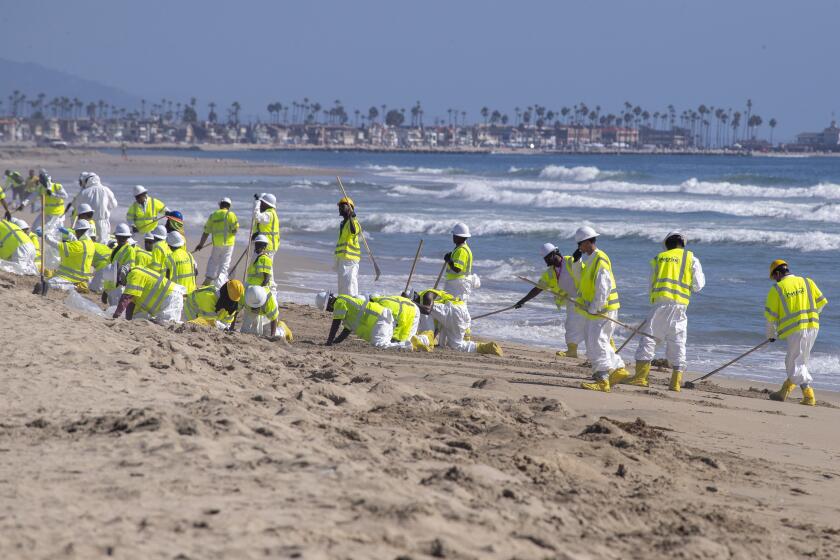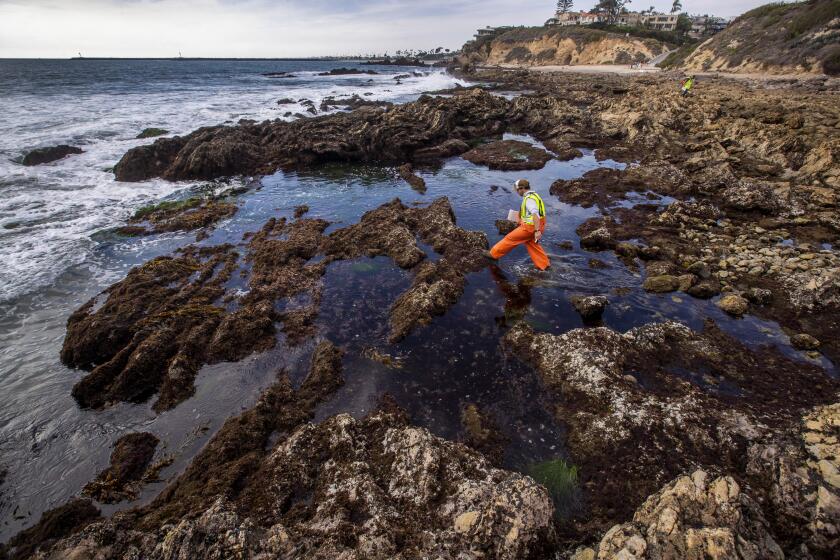Oil, tar wash ashore in San Diego County as O.C. oil spill cleanup extends

Small amounts of oil and tar washed ashore as far south as San Diego County on Thursday as cleanup and recovery efforts accelerated following the oil spill along the Orange County coast.
Officials said they’ve made progress in the cleanup and hope to advance even further over the weekend. But a storm that meteorologists say could bring 20-mph winds to the region is moving in, raising concerns that more oil could reach the shores. So far, much of the crude has remained offshore, but striations have been seen in Huntington Beach and Laguna Beach.
More than 800 people have been clearing oil from Sunset Beach in Huntington Beach to Carlsbad. By the end of the week, officials expect to ramp that number up to 1,500.
A pollution-control vessel has been working off the Huntington Beach coast where a plume of oil has lingered since the spill. Two other vessels were tackling another slick that has slowly moved south over the past four days and is now off the coast of San Clemente, maps show.
More than 5,500 gallons of crude oil have been recovered and 12,860 feet — almost 2½ miles — of containment boom have been deployed to protect beaches, according to the Coast Guard.
As the oil is exposed to the sun, wave action, tides and currents, its behavior and characteristics change, said Rebecca Ore, commander of the U.S. Coast Guard Sector Los Angeles-Long Beach.
“Our overflights are continuously monitoring what that offshore condition looks like and what the oil looks like, and we are seeing trends that indicate ... lighter sheen and less heavy oil,” she said.
North of the Huntington Beach Pier on Thursday morning, a worker in a white hazmat suit picked up a quarter-sized clump of oil, lifted it to his nose and sniffed. Recognizing the smell of crude, he used a gloved hand to lower the tar ball into a plastic trash bag.
He was one of 60 people combing the shore of Huntington State Beach. Some carried orange nets called screeners, which allowed them to sift oil while leaving the sand intact. Others, poised like human derricks, were stooped over and picking up the crude by hand.
The crews have made progress cleaning the stretch of beach over the past five days. Signs of the black rings and clumps of crude that littered the shore following the weekend spill have started to disappear.
“Make sure you’re checking under the leaves!” one worker yelled, turning a piece of kelp over in his hands.
Crews are also surveying the coast in search of wildlife disturbed by the spill. As of late Wednesday, they had recovered 19 live oiled birds: six western grebes, five snowy plovers, a sanderling, an eared grebe, an American coot, a ruddy duck, a double-crested cormorant, a clark’s grebe, a California gull and a brown pelican. Three double-crested cormorants, an American coot and a western gull were found dead, according to the Oiled Wildlife Care Network.
A video of the seafloor off the Orange County coast this week shows damage to an oil pipeline that sent up to 131,000 gallons of crude into the ocean, fouling beaches and threatening ecologically sensitive wetlands.
The footage, taken by a remotely operated vehicle on Monday, appears to show a portion of the 4,000-foot section of the nearly 18-mile oil pipeline that had been displaced. Divers reported and video showed a 13-inch split along the concrete-encased, steel pipe’s length, according to the joint unified command overseeing the response to the spill.
Martyn Willsher, president and chief executive of the pipeline operator’s parent company, Amplify Energy Corp., described the force as pulling the pipe in an almost “semicircle.”
“The pipeline has essentially been pulled like a bowstring,” he said.
A massive oil spill off the Orange County coast has fouled beaches and killed birds and marine life
Federal sources told The Times this week that the displacement could best be explained by a ship’s anchor dragging across the ocean floor and hooking the pipeline, which runs from the Port of Long Beach to an offshore oil platform known as Elly.
There were multiple large cargo vessels in the immediate area of the leak before the oil was spotted.
On Thursday evening, lawyers gathered in Huntington Beach to announce the first class-action lawsuit filed on behalf of Orange County business owners seeking damages related to the spill.
The first plaintiff in the suit is Banzai Surf School, which has operated in Huntington Beach for 12 years and is located in “what, for all intents and purposes, has become ground zero for the spill,” said owner Jaz Kaner.
Kaner estimates that his surf school will lose tens of thousands of dollars in the first week of October, a month he called “prime time for surfing in California.”
Mike Ali, owner of Zack’s, an oceanside rental shop in Huntington Beach, said his family’s business will suffer.
“It’s devastating — mentally, economically, physically ... for me and my family,” said Ali, who has owned beachside businesses in Orange County for 31 years. “I have about 20 employees I have to lay off.”
Other local businesses are expected to join the class action. Attorneys, meanwhile, vowed to seek justice for their clients.
“I don’t think we know quite yet how many businesses this will impact, but it could be thousands or tens of thousands,” said Kelly Weil, an attorney from Cotchett, Pitre & McCarthy’s Santa Monica office.
The lawsuit against Amplify Energy Corp. and its subsidiaries was filed on behalf of industries that operate along the water, including restaurants, tourism and commercial fishing.
Additional parties — including a “phantom ship” suspected of dropping the anchor that yanked and slashed the pipeline — will be sued once they are identified, attorneys said.
“I don’t want to leave anybody with an impression that we are convinced that only Amplify is liable here,” said Robert Hutchinson, an attorney on the case. “Anybody and everybody that had anything to do with causing a leak is going to be brought into the lawsuit.”
Rotterdam Express, the ship probed in O.C. oil spill, no longer under investigation, company says.
A final determination for the cause of the spill may take months, but Coast Guard investigators have come up with no other explanation, federal sources said. Authorities said the video confirms that oil is no longer leaking from the 41-year-old pipeline.
Pipeline expert Richard Kuprewicz expects investigators to remove the damaged pipeline, then begin a metallurgical examination of the steel.
“When did the strain occur?” he asked. “Days before? Or did something in its operation cause it to rupture Friday night? The forensic science is sophisticated, and they should be able to tell if the damage was delayed or immediate.”
Authorities have not provided an update on the investigation. Estimates for the amount of oil that spilled into the ocean have varied over the past five days. Coast Guard officials said Thursday that between 24,696 gallons and 131,000 gallons of oil leaked out of the pipeline. They were unable to narrow that estimate.
Ore said the 131,000-gallon estimate is a “maximum worst-case discharge that is a planning scenario based on a volume in a pipeline.”
Rep. Mike Levin (D-San Juan Capistrano), who toured the spill this week by boat and helicopter, said he could see oil stretching down the coast. He’s pushing legislation that would ban future offshore drilling, but he’s also interested in phasing out drilling that’s currently underway. The offshore oil infrastructure is aging and creating more risk of ecological disaster, he said.
“It’s just not worth drilling along Southern California’s coast,” he said. “The amount of oil we produce really is a drop in the bucket.”
Scientists say shifting currents could push thicker parts of the oil slick ashore, which would be devastating for ecosystems
The beaches and water that have been fouled by the spill are on the ancestral homelands of the Acjachemen and Tongva people. Stretches of sand in Huntington Beach and parts of Newport Beach have been the most severely impacted.
Some oil has also washed up in Laguna Beach and Dana Point, officials said. As a large plume continues to drift south, officials in San Clemente and San Diego County beaches are bracing for possible oil on their shores as well.
Lifeguards in Oceanside found two small tar balls on the beach Wednesday night. Authorities in Carlsbad and Encinitas also reported some tar. However, officials are not certain whether the tar is from the spill or normal ocean debris that sometimes washes ashore, said Terry Gorman Brown, a management analyst with the city manager’s office in Oceanside.
The Coast Guard sent cleanup teams to beaches south of Camp Pendleton and is flying over the area multiple times a day to track for oil. Oceanside is prepared to deploy a boom to protect its harbor, if necessary, Gorman Brown said.
“The most south they’ve seen a sheen is about 12 miles off the coast of San Onofre,” Gorman Brown said. “We’re seeing how it goes.”
The Department of Fish and Wildlife has expressed concern about the potential for oil making its way into the Agua Hedionda Lagoon in Carlsbad, which feeds into the Claude “Bud” Lewis Carlsbad Desalination Plant. Officials said Thursday afternoon they’re deploying a boom at the mouth of the lagoon as a precaution.
The plant, which provides about 50 million gallons of water daily to San Diego County, has not been affected, said Scott Maloni, Poseidon Water’s vice president of project development.
In San Clemente, there was no sign of disruption from the spill that has spoiled beaches in the northern section of Orange County.
Sheri Cowell walked to a bench overlooking the pier — just as she does every day. She scanned the coastline for oil but didn’t see anything unusual.
“I figured it’d be coming; just don’t know when,” Cowell said.
Frank Lomonico was fishing Thursday off the San Clemente Pier for mackerel that he planned to use in lobster traps.
Amid a steady drizzle, the Dana Point resident lamented that with the harbor closed, he wouldn’t be able to go lobstering.
“Why even live here if we keep polluting?” said Lomonico, 71. “There’s no need to take oil out of the ocean. There’s too many surfers, fishermen, businesses and cities that depend on it.”
Times staff writers Richard Winton, Chris Megerian, Rosanna Xia, Anita Chabria, Thomas Curwen and Gregory Yee contributed to this report.
More to Read
Start your day right
Sign up for Essential California for news, features and recommendations from the L.A. Times and beyond in your inbox six days a week.
You may occasionally receive promotional content from the Los Angeles Times.












